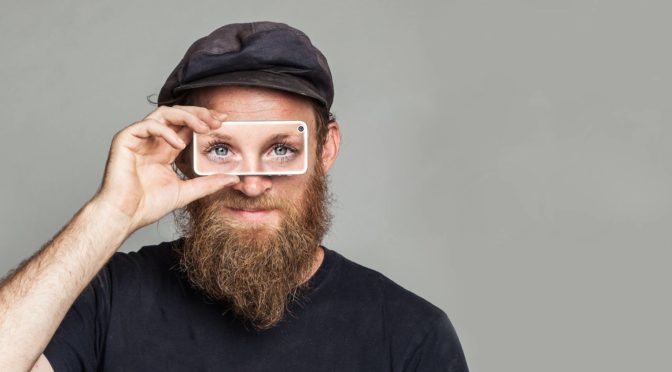On May 11 from 5:00 t0 7:00 p.m., LightHouse will host Be My Eyes and its blind or low vision users for an evening of creative use, feedback and even a bit of friendly competition. The Be My Eyes team will take blind users through the past, present and future of the technology, and share some incredible stories about the iPhone app that connects blind people to a network of sighted volunteers via live video chat. The event is free and intended for blind and low vision users – RSVP on Facebook.
We love our independence. Even if our vegetables are grown and picked by hundreds of hands, our cars designed by teams of closely collaborating engineers, and everything from our electricity to our government benefits kept running by vast networks of individuals — modern day technology and consumption are designed to make us feel self sufficient.
We are thus allowed to hold ourselves ideals of self-determination and rugged individualism that have been passed down over the centuries. As blind people, these values are challenged every day of our lives. When something is poorly designed or downright unusable, we confront a deep conundrum: going it alone or asking for help, and risking the perceived possibility of burdening others.
When Be My Eyes launched nearly two years ago, a new tool was born: a radically different way to ask for help. Be My Eyes introduced blind smartphone users to a whole new type of social support network, one unbounded by geography, bureaucracy, or even practical limitations, that allowed blind users to get sighted assistance via video chat.
Today there are about half a million sighted volunteers with Be My Eyes loaded onto their phones, with more than 30,000 blind users on the other end. These volunteers will do anything from help you adjust the thermostat to spending half an hour helping you pick out an outfit for a high-stakes presentation. But at it’s core, each interaction is random, at-will and obligation free. The free app puts no limit on the number of calls you can make in a day. If you really wanted to, you could call 100 different people and have each of them identify the exact same piece of art – and the service, as always, would be free.
Even though thousands of blind people benefit from this app every week, the platform can handle thousands more. I wonder often if our notion of independent living so engrained, so hard-wired that we have still have trouble asking for help, even when there are really no strings attached.
Be My Eyes is working toward a gold-standard for people helping people. They have hundreds of thousands of hours of free labor, given with good faith, at a moments notice from people all around the world. It’s truly a new tool – like a fishing pole that reels in assistance whenever you want it. But as the old saying goes, you have to “teach a man to fish” before he can really benefit from the tools at hand.
Last month, I challenged myself to re-consider how I use the app. Occasionally I will be somewhere, alone, and realize that I am struggling. We all do this, sighted and blind alike: make things harder for ourselves then they need to be.
For one week, I told myself, any time I needed help I would pull out the app and give it a spin. What came out of it was surprising. Watch the video below to see Be My Eyes in action.
Not only did I use it for things I never thought it could work for – like identifying house numbers as I walked through a neighborhood or even the types of fish on my sushi plate – but I met people who were patient, not overbearing, and curious as to what they could do to be helpful without being obtrusive.
No one asked me personal questions, no one tried to coach me on how to live my life, and above all no one grabbed me by the arm and steered me somewhere I didn’t want to go. When I got what I needed, I could politely say thank you and hang up without fear that being brisk with someone would have repercussions later. It’s all the value of having someone nearby without any of the additional worry of initiating contact, explaining yourself, and ultimately breaking free of their of custody.
Our understanding of “independence” is not truly about total independence, but instead about masking the assembly line of helpers which make up our lives: the tiny little micro-transactions where individuals step in to provide assistance, whether or not we have a disability. For blind people, this is a more obvious reality than for most.
The reason Be My Eyes is so remarkable is because it embraces this reality wholesale: You can get the tiniest bit of help and move on through your life. The safety net is huge, and yet doesn’t loom over you.
Maybe it makes sense, then, that the guys behind Be My Eyes hail from Denmark, where you’re much more likely to hear about a more “social” approach. And if we think of human interaction as give and take, as an exchange of ideas or assistance as a true social interaction – maybe Be My Eyes has created the first truly social network.

